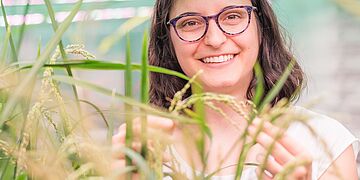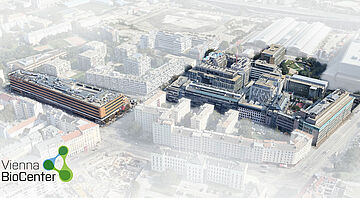
Biochemistry, Biophysics, Structure
How do individual molecules combine to perform complex biological functions?
Scientists at the Vienna BioCenter are using bottom-up approaches to discover how individual molecules assemble into sophisticated 3D structures that perform highly specialized cellular functions. By combining biochemistry research, biophysics research, and state-of-the-art structural methods, scientists are resolving macromolecular complexes at atomic resolution, reconstituting multi-component complexes in vitro, studying protein-ligand interactions, and observing molecular machines in action.

Understanding the 3D structures of biological macromolecules and complexes such as the nuclear pore and the proteasome, and learning how they acquire these structures, is key for understanding their diverse and specialized functions. Three basic scientific disciplines are central to this field and synergize at the Vienna BioCenter: biochemistry, biophysics, and structural biology. Traditional biochemistry research is increasingly complemented by the related discipline of biophysics, which applies approaches and methods in physics to study biomolecules and their interactions. Structural biology, a branch of biochemistry and biophysics, provides ever more detailed views of complex biomolecules. These interrelated disciplines are crucial for understanding how macromolecular machines form and function, and what causes them to malfunction, which can provide important insights into many different human diseases.

At the Vienna BioCenter, scientists from nearly half of the 90 research groups extensively employ such interdisciplinary approaches to directly observe, model, and manipulate biomolecules and their complexes. Techniques in regular use include single-molecule biochemistry, cryo-electron microscopy (EM), X-ray crystallography, NMR, mass spectrometry, protein complex stoichiometry analysis, and fluorescence imaging. In particular, researchers in the structural biology labs are exploiting recent developments in single particle cryo-EM and contributing to further technological progress. Cryo-EM can solve the structures of large macromolecular complexes at high resolution and visualize macromolecular machines in action. For example, our scientists have used the technique to study different functional states of the 1.5-MDa anaphase-promoting complex, which is a key regulator of the cell cycle.

Our researchers are using the above approaches to gain groundbreaking insights into the molecular mechanisms underlying a wide range of fundamental cellular processes such as chromosome segregation and cell division, signal transduction, protein quality control and degradation, viral infection, RNA processing, post-transcriptional regulation, ciliogenesis, and muscle contraction.
Infrastructure and support for these endeavors are provided by the Electron Microscopy Facility, the Metabolomics Facility, and the Protein Technologies Facility. In coordination with these Core Facilities, scientists at the Vienna BioCenter are continually pushing the boundaries of current technologies, both experimental and computational, to answer biological questions in completely new ways.
Research Groups "Biochemistry, Biophysics, Structure"
| Research Group | Institute | Topic |
|---|---|---|
| Berger | GMI | Chromatin Architecture and Function |
| Dagdas | GMI | Autophagy-mediated cellular quality control mechanisms in plants |
| Ramundo | GMI | Chloroplast biogenesis and protein quality control |
| Brennecke | IMBA | Transposon silencing & heterochromatin formation by small RNAs |
| Gerlich | IMBA | Chromosome structure and dynamics |
| Goloborodko | IMBA | Theoretical Models of Chromosome Structure |
| Saha | IMBA | Role of macromolecular phase separation in germline cell fate and totipotency |
| Balzarotti | IMP | Advanced Light Microscopy and Biophysics |
| Clausen | IMP | Molecular mechanisms of protein quality control |
| Haselbach | IMP | Watching molecular machines in action |
| Pauli | IMP | Functions of short translated open reading frames (ORFs) in the context of development |
| Peters | IMP | Mitosis and chromosome biology |
| Pinheiro | IMP | Mechanics and signalling dynamics in embryogenesis |
| Plaschka | IMP | mRNA processing and regulation |
| Stark | IMP | Understanding transcriptional regulation |
| Ameres | Max Perutz Labs | Mechanism and Biology of RNA Silencing |
| Bachmair | Max Perutz Labs | Protein modifiers in plants |
| Campbell | Max Perutz Labs | Mechanisms that ensure chromosome segregation fidelity in mitosis |
| Djinovic | Max Perutz Labs | Structural Biology of the Cytoskeleton |
| Dong | Max Perutz Labs | Structural studies of ciliogenesis |
| Falk | Max Perutz Labs | Biogenesis and Action of small RNAs |
| Foisner | Max Perutz Labs | Lamins in nuclear organization and human disease |
| Huis in 't Veld | Max Perutz Labs | Preventing DNA damage during mitosis |
| Juffmann | Max Perutz Labs | Quantum Microscopy and Biophysics |
| Karagoez | Max Perutz Labs | Protein quality control in the endoplasmic reticulum |
| Koehler | Max Perutz Labs | Nuclear Pores - Regulators of Chromatin and Membrane Dynamics |
| Konrat | Max Perutz Labs | Computational Biology and Biomolecular NMR Spectroscopy |
| Kuchler | Max Perutz Labs | Host-Pathogen Interactions & Mechanisms of Drug Resistance & Fungal Pathogenesis |
| Leonard | Max Perutz Labs | Structural Biology of Lipid-Activated Signal Transduction |
| Martens | Max Perutz Labs | Molecular Mechanisms of Autophagy |
| Martinez | Max Perutz Labs | Biochemistry, physiology and disease of the tRNA splicing pathway in mammalian cells |
| Moll | Max Perutz Labs | Ribosome Heterogeneity in Bacteria |
| Nimpf | Max Perutz Labs | ApoER2 and VLDL Receptor |
| Ogris | Max Perutz Labs | PP2A enzyme biogenesis and monoclonal antibodies |
| Otsuka | Max Perutz Labs | Intra-cellular Communication between the ER and the Nucleus |
| Ries | Max Perutz Labs | Super-resolution microscopy for structural cell biology |
| Schloegelhofer | Max Perutz Labs | Meiotic Recombination |
| Slade | Max Perutz Labs | DNA damage response |
| Zagrovic | Max Perutz Labs | Molecular Biophysics |
| Boettcher | Uni Vienna - CeMESS | Chemistry of Microbial Interactions & Microbe-Phage Interactions & Secondary Metabolites & Antibiotics |



